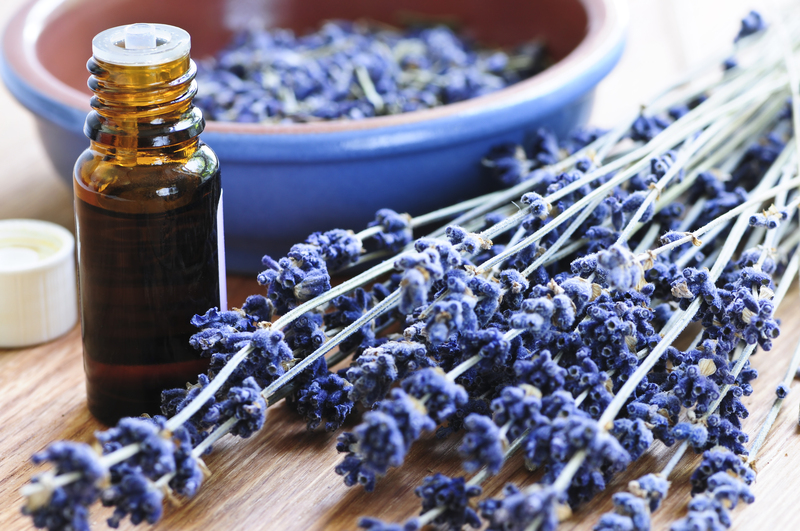Uncover the Science Behind Perfectly Clean Windows
Posted on 28/06/2025
Uncover the Science Behind Perfectly Clean Windows
There's something magical about the way sunlight streams through clean windows. Whether you're trying to let in more light, improve your home's curb appeal, or simply enjoy the clarity that streak-free glass provides, the art and science of achieving perfectly clean windows is more sophisticated than meets the eye. In this comprehensive guide, we'll dive into the science behind spotless windows, examine the best cleaning techniques, explore the chemistry at work, and reveal the most effective products for crystal-clear glass.

Why Are Clean Windows So Important?
Perfectly cleaned windows do much more than beautify your home. Let's look at why regular, thorough cleaning isn't just for aesthetics:
- Improves natural light: Dirt, grime, and streaks reduce the amount of sunlight entering your home, making rooms feel dull and less inviting.
- Enhances well-being: Studies show more natural light can boost your mood, increase productivity, and even improve sleep.
- Prolongs window lifespan: Removing contaminants like hard water deposits and dirt helps prevent etching and decay on glass and window frames.
- Raises property value: Sparkling, streak-free glass significantly enhances curb appeal and creates an excellent first impression for visitors or potential buyers.
The Science of Dirty Windows
What Makes Glass Dirty?
To uncover the science behind window cleaning, we must first understand why glass gets dirty:
- Dust and Pollen: These particles adhere to the glass due to static electricity and moisture.
- Pollution and Acid Rain: Chemical compounds in the air break down and stick to windows, often causing hazy residues.
- Hard Water Stains: Mineral-rich water (like from lawn sprinklers or rain) leaves calcium and magnesium behind, resulting in cloudy spots.
- Fingerprints and Oils: Oils from skin and everyday contact add smudges and grease to the surface.
- Bird Droppings and Insects: Organic waste bonds strongly with glass, making it harder to remove over time.
The Chemistry at Work
Glass appears smooth, but under a microscope, it's filled with tiny valleys and peaks. When dirt, minerals, or oils settle, they cling to these microscopic crevices, requiring special consideration when cleaning.
Moreover, mineral deposits have a chemical bond with the glass surface, especially after prolonged exposure. This necessitates either mechanical or chemical intervention, such as using acidic solutions (like vinegar) to break down alkaline deposits.
The goal isn't just to remove visible grime, but also to eliminate microbes and residues at a molecular level for long-lasting spotless windows.
Methods and Tools: Achieving the Ultimate Window Clean
The Essentials for Immaculate Glass
- Microfiber Cloths: Their unique structure ensures optimal dirt and water absorption without scratching glass.
- Squeegees: The professional's choice for a streak-free finish, they employ a rubber blade to remove water and detergent in a single pass.
- Window Cleaning Solutions: The best contain surfactants (surface-acting agents) that lower water's surface tension, helping lift and trap dirt for easy removal.
- Distilled Water: Using mineral-free water prevents spots and streaks caused by calcium and magnesium.
How to Clean Windows Like a Scientist
Cleaning windows effectively isn't just about elbow grease. It's about leveraging physics and chemistry for outstanding results. Here's a step-by-step, science-backed method:
-
Pre-clean Dust and Debris
Remove dust, spider webs, and loose dirt with a dry microfiber cloth or soft brush before applying liquids, preventing muddy streaks. -
Prepare the Cleaning Solution
Mix a few drops of mild detergent or specialized window cleaner in a bucket of warm distilled water. For natural cleaning, combine equal parts white vinegar and water. -
Apply Solution Liberally
Use a sponge or spray bottle to wet the glass. The goal is to fully dissolve adhered grime and mineral deposits, allowing surfactants to lift the particles away. -
Scrub for Science
Using a soft microfiber cloth, gently scrub from top to bottom. For stubborn spots, apply a paste of baking soda and water or a commercial lime remover. -
Squeegee Away
Starting at the top, drag the squeegee in straight, overlapping strokes. Wipe the blade after each pass to avoid re-depositing dirt. -
Final Buff & Inspect
Use a dry microfiber cloth or newspaper for final buffing. Inspect in natural light for streaks or missed spots.
Advanced Tips for Pristine Glass
- Clean on Cloudy Days: Sunlight can evaporate water and cleaning solution before you wipe it off, causing streaks.
- Avoid Ammonia: While effective on some surfaces, ammonia-based cleaners can damage window tint and are not environmentally friendly.
- Switch Directions: Wipe inside windows horizontally and outside vertically. This makes it easier to identify which side a streak is on.
- Double Rinse: Follow up any detergent cleaning with a rinse of pure distilled water to prevent residue buildup.
The Role of Water Quality in Streak-Free Windows
One of the biggest factors influencing the final result is the type of water you use. Tap water often contains minerals that remain on the glass after drying, leading to unsightly spots and streaking. Distilled water, on the other hand, is free of minerals, ensuring a perfect finish.
Why Distilled or Deionized Water?
- No Residue: Because impurities are removed, there is less chance of spotting.
- Improved Cleaning: Distilled water can dissolve cleaners more effectively and leaves no residue behind.
- Better for Equipment: Using mineral-free water is also easier on your squeegee, spray bottles, and cloths, prolonging their lifespan.
Professional window cleaning companies often use water-fed pole systems, which utilize deionized water for strictly this reason!
The Impact of Cleaning Agents: The Chemistry Explained
The right choice of cleaning solution makes all the difference. Here's how various chemicals work to clean your glass:
- Surfactants: Molecules that lower water's surface tension, allowing it to spread, surround, and lift away dirt particles more effectively.
- Acidic Agents (like vinegar): These break down alkaline mineral deposits, making them easier to wipe away.
- Alcohol (isopropyl): Speeds evaporation and helps dissolve greasy fingerprints, minimizing streaks.
- Ammonia: Strong for eliminating oily residues but not suited for all surfaces and can damage plastics or tints.
TIP: For eco-friendly window cleaning, opt for biodegradable, non-toxic formulations that clean without harming your family or the planet.
Beyond Glass: The Whole Window System
Pristine windows aren't just about clean glass. Frames, tracks, and screens must also be addressed for complete clarity and hygiene:
- Clean window screen: Remove and gently wash with soapy water and a soft brush, then rinse and air dry.
- Wipe tracks and sills: Use a vacuum followed by a damp cloth to remove dust, bugs, and debris, improving window operation and appearance.
- Inspect seals: Ensure no water leaks or drafts are present after cleaning.
Common Cleaning Challenges (and Solutions!)
How to Solve Streaking Issues
- Use less detergent: Too much soap leaves a film that causes streaks.
- Buff while damp: Waiting until the glass is completely dry makes streaks harder to remove.
- Replace old squeegee blades: Worn rubber can leave lines and not fully sweep away moisture.
Removing Tough Stains and Deposits
- Hard water stains: Use a solution of equal parts vinegar and water. For tough stains, commercial lime or calcium removers can help.
- Sticky residue: Rub with isopropyl alcohol on a soft cloth, then wipe clean.
- Paint or construction debris: Gently scrape with a razor blade at a 45-degree angle, lubricated with cleaning solution, to avoid scratching.
TIP: Always test any cleaning method on a small, inconspicuous section first!
The Environmental and Health Benefits of Clean Windows
Did you know cleaner windows can positively impact indoor air quality and energy use?
- Reduces allergens: Removing pollen, dust, and mold spores from windows and frames helps limit allergy symptoms.
- Saves energy: More sunlight entering through clean windows can help warm your home naturally, lowering heating bills in colder months.
- Boosts air circulation: Functional, clean windows open more easily, helping ventilate your home safely.
Clean windows may simply look beautiful, but their positive impact extends to your family's health and comfort.
Top Myths About Perfectly Clean Windows -- Debunked!
- "Newspaper is the best for cleaning glass." While newspaper used to be effective due to its lint-free, high-fiber paper and lead-based ink, today's soy inks and softer papers can smear and leave residue. Microfiber is superior!
- "All cleaners work the same." The specific chemical makeup of a cleaning agent can make a dramatic difference in cleaning power and the degree of streaking left behind.
- "It's best to clean windows on a sunny day." The heat can cause solutions to evaporate too quickly, increasing streaks. Aim for an overcast day instead.

Professional Techniques for Spotlessly Clean Windows
Why Hire a Professional?
Expert window cleaners often achieve results that seem unattainable with household tools. They use:
- Pure, deionized water and advanced filtration systems for a streak-free rinse.
- Specialized squeegees and T-bars designed for all window shapes and sizes.
- Extension poles and ladders to safely access high or hard-to-reach areas.
- Trained techniques to minimize drips and guarantee a pristine finish.
Consider hiring a pro for multi-story homes or elaborate window designs for the ultimate in safety and shine.
Conclusion: Unlock the Science, Enjoy the Shine
Achieving perfectly clean windows is more than just a chore -- it's a science. Understanding the properties of glass, the chemistry of cleaning agents, and the physics of washing and drying allows anyone to create crystal-clear, streak-free views.
To summarize, here's what unlocks the secret to truly spotless windows:
- Pre-clean dry dust and debris
- Use the right solution and clean, soft tools
- Utilize distilled water whenever possible
- Adopt professional techniques like squeegeeing and microfiber buffing
- Address window frames, tracks, and screens for a holistic clean
Apply these principles and experience the transformative power of scientifically cleaned windows -- your home, garden, or office will never look brighter or more welcoming.
If you found this article helpful, consider sharing it with fellow clean-conscious friends, and let the science of perfectly clean windows illuminate your world!





